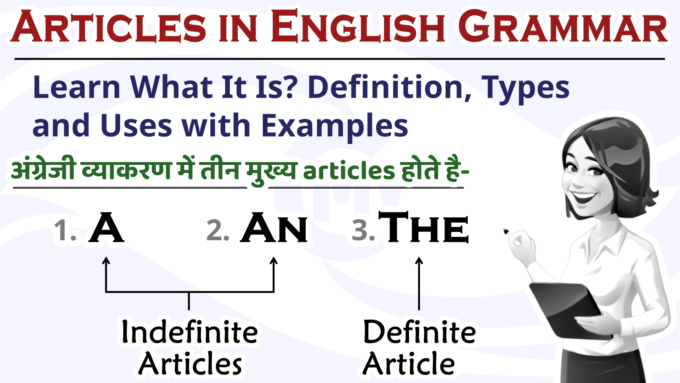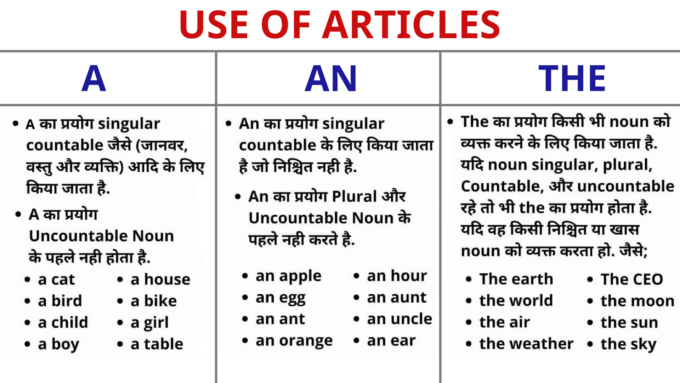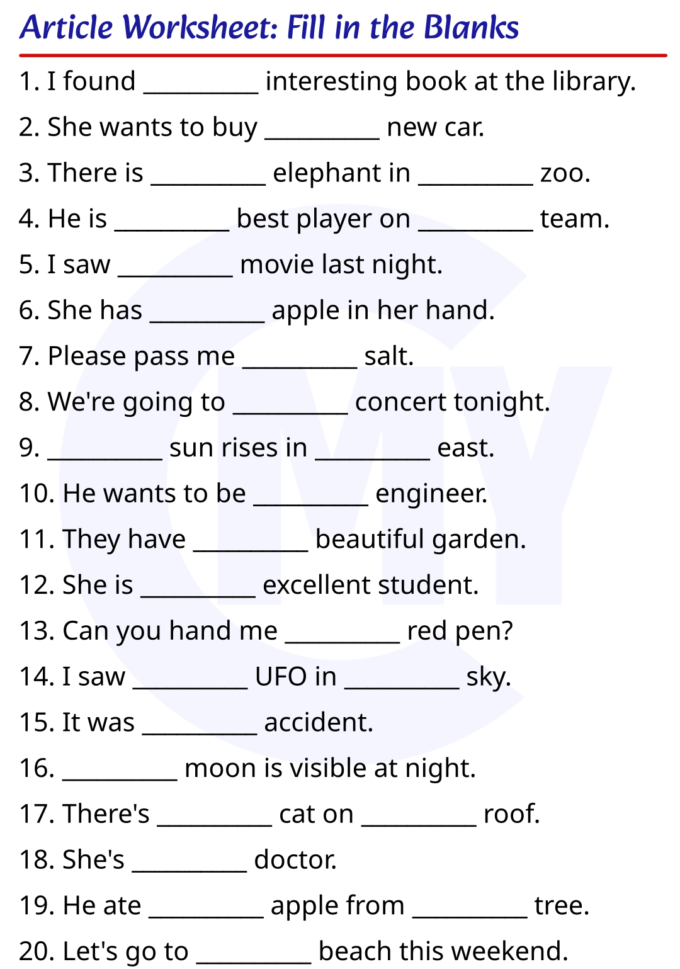In English grammar, articles are a type of determiner that come before nouns to provide more information about the noun. Articles help specify whether a noun is definite or indefinite and whether it refers to something specific or something more general.
व्याकरण में articles एक प्रकार के निर्धारक (determiner) होते हैं जो संज्ञा (noun) के बारे में अधिक जानकारी प्रदान करने के लिए संज्ञा से पहले आते हैं। Articles यह निर्दिष्ट करने में मदद करते हैं कि क्या कोई संज्ञा निश्चित या अनिश्चित है और क्या यह किसी विशिष्ट या कुछ अधिक सामान्य को संदर्भित करती है।
There are three main articles in English: “the,” “a,” and “an.” (अंग्रेजी व्याकरण में तीन मुख्य articles होते है- “the,” “a,” और “an”.)
Definite Article (“the”): The definite article “the” is used when you are referring to a specific or known item or group of items. It indicates that the noun it modifies is unique or has already been mentioned or is understood in the context.
- Example 1: “The cat is on the roof.” Here, “the” indicates that we are talking about a specific cat, not just any cat.
- Example 2: “I saw a movie. The movie was great.” In the second sentence, “the” is used because we are referring back to a specific movie mentioned earlier.
Indefinite Articles (“a” and “an”): The indefinite articles “a” and “an” are used when you are referring to a non-specific or unknown item or one of many. The choice between “a” and “an” depends on the sound that follows the article.
- Example 1: “I saw a cat in the yard.” Here, “a” is used because the cat is not a specific cat; it’s just one of many possible cats.
- Example 2: “She gave me an apple.” In this case, “an” is used because “apple” begins with a vowel sound.
It’s important to note that articles are a fundamental part of English grammar and can significantly affect the meaning of a sentence. Using the wrong article or omitting one when it’s needed can lead to misunderstandings. Additionally, some languages have more complex systems of articles or may not use articles at all, so it’s important to be aware of the specific rules for articles in English if it’s not your native language.
Indefinite Article “‘A’ and ‘AN'”
The indefinite article, “a” or “an,” is used before a singular noun that is nonspecific or unknown to the listener. It indicates that there is one of something but does not specify which one. “A” is used before words starting with a consonant sound, while “an” is used before words starting with a vowel sound.
Indefinite Article के प्रयोग के प्रमुख Rules निम्नलिखित हैं-
Use of ‘A’:
RULE: Nouns whose first letter is not A, E, I, O, or U, and which produce a consonant sound, are preceded by the indefinite article “A” in English.
जिन Nouns का पहला अक्षर A, E, I, O, U न हो और जिनसे व्यंजन ध्वनि निकले, उनसे पूर्व एक (One) की अंग्रेजी के लिए ‘A’ का प्रयोग किया जाता है।
A का प्रयोग– निम्नलिखित उदाहरणों को ध्यानपूर्वक पढ़िए-
- This is a bird.
- That is a horse.
- That is a chair.
- This is a pen.
उपर्युक्त वाक्यों से स्पष्ट है कि-
- Bird, Horse, Pen और Chair सभी Common Nouns हैं। ये जिन प्राणियों या वस्तुओं को बताते हैं, उन्हें गिना जा सकता है अर्थात ये Countable Nouns हैं।
- ये सभी Nouns एकवचन (Singular Number) के हैं। इन सबका पहला अक्षर व्यंजन (Consonant) से आरम्भ होता है और इनकी व्यंजन ध्वनि भी है।
- इन सबके पहले ‘A’ का प्रयोग किया गया है।
नोट– ये सब शब्द एकवचन (Singular Number) के अर्थात Singular Nouns होने चाहिए।
Use of ‘An’:
RULE: The words whose first letter (letter) is a vowel (one of A, E, I, O, U) and their pronunciation begins with a vowel sound, are preceded by the indefinite article “An” in English.
जिन शब्दों का पहला अक्षर (Letter) स्वर (A, E, I, O, U में से कोई एक) हो और उनका उच्चारण भी स्वर ध्वनि से हो तो उनसे पहले एक (One) की अंग्रेजी के लिए ‘An’ का प्रयोग किया जाता है।
An का प्रयोग– निम्नलिखित उदाहरणों को ध्यानपूर्वक पढ़िए-
- This is an ant.
- That is an elephant.
- That is an umbrella.
- That is an owl.
- He has an ass.
- This is an inkpot.
- This is an ox.
- Here is an orange.
उपर्युक्त वाक्यों से स्पष्ट है कि-
- Ant, Elephant, Inkpot, Umbrella, Ox, Owl, Orange, Ass सभी Common Nouns हैं।
- ये जिन प्राणियों या वस्तुओं को बताते हैं, उन सबको गिना जा सकता है अर्थात ये सब Countable Nouns हैं।
- ये सभी Countable Nouns- Singular Number के हैं अर्थात इन सबका प्रयोग एकवचन में किया गया है।
- इनमें से प्रत्येक का पहला अक्षर स्वर (Vowel) से आरम्भ होता है और इनकी स्वर ध्वनि भी है।
- इन सबसे पहले ‘An’ का प्रयोग किया गया है।
नोट: A, E, I, O, U स्वर (Vowels) हैं। अंग्रेजी वर्णमाला (Alphabets) के शेष सभी अक्षर व्यंजन (Consonants) कहलाते हैं।
स्वरों (Vowels) के साथ ‘A’ का प्रयोग
RULE: यदि A, E, I, O और U से प्रारम्भ होने वाले शब्दों का उच्चारण व्यंजन ध्वनि से आरम्भ हो तो इन शब्दों से पहले एक की अंग्रेजी के लिए ‘A’ का ही प्रयोग किया जाता है।
निम्नलिखित उदाहरणों को ध्यानपूर्वक पढ़िए-
- Mr. Garg is a professor in a university.
- Dr. James is a European.
- He is a one-eyed man.
- This is a useful book..
- I have a one rupee note in my pocket.
उपर्युक्त वाक्यों से स्पष्ट है कि- University, European, One-eyed, Useful से पहले Indefinite Article – A का प्रयोग किया गया है यद्यपि ये सभी शब्द Vowels से आरम्भ होते हैं क्योंकि इन शब्दों का उच्चारण व्यंजन (Consonant) ध्वनि से आरम्भ होता है।
व्यंजनों (Consonants) के साथ ‘An’ का प्रयोग
RULE: किसी शब्द के आरम्भ में व्यंजन होने पर भी एक की अंग्रेजी में ‘An’ का प्रयोग किया जाता है, यदि शब्द का उच्चारण स्वर ध्वनि (Vowel Sound) से हो।
निम्नलिखित उदाहरणों को ध्यानपूर्वक पढ़िए-
- Amjad will finish his work in an hour.
- You are an honest boy.
- Vijai is an heir to my property.
यहाँ Hour, Honest और Heir से पहले ‘An’ का प्रयोग हुआ है क्योंकि इन शब्दों का उच्चारण स्वर ध्वनि (Vowel Sound) से हुआ है, अर्थात इन शब्दों के उच्चारण में H (ह) नहीं बोला जाता है।
Definite Article “THE”
The definite article, “the,” is used before a noun to refer to a specific or previously mentioned person, thing, or idea. It indicates that the noun is known, identifiable, or has been previously mentioned in the conversation or context.
Definite Article में केवल एक शब्द का ही प्रयोग होता है। वह शब्द है- ‘The’. The का प्रयोग समझने के लिए निम्नलिखित उदाहरणों को ध्यानपूर्वक पढ़िए-
- This is a cow.
- This is a tree.
- The cow is under the tree.
उपर्युक्त उदाहरणों से स्पष्ट है कि-
- Cow और Tree का प्रथम बार परिचय कराने के लिए पहले ‘A’ का प्रयोग किया गया है।
- जब ये ही Nouns वाक्य में दोबारा प्रयोग किये गये तो इनके साथ Definite Article- The का प्रयोग किया गया है।
व्याकरण की भाषा में इसे इस प्रकार व्यक्त किया जाता है-
RULE: निश्चित प्राणी, वस्तु या स्थान के पूर्व The का प्रयोग किया जाता है।
Unique things and Proper noun
Unique things and Proper noun is preceded the definite article ‘THE’.
अद्वितीय वस्तु अर्थात अपनी तरह की अकेली वस्तु एवं Proper Noun (व्यक्तिवाचक संज्ञा) से सम्बन्धित कुछ वाक्य निम्नलिखित हैं। इन्हें ध्यानपूर्वक पढ़िए-
- The sun is rising in the sky.
- The Taj is a famous building.
- The Ganga rises in the Himalayas.
- London is on the Thames.
उपर्युक्त उदाहरणों से ज्ञात होता है कि-
- ‘The’ का प्रयोग ऐसे Nouns से पहले किया गया है जो संसार में अद्वितीय हैं अर्थात अपनी तरह के अकेले हैं।
- नदियों और पर्वत श्रेणियों (शृंखलाओं) से पूर्व ‘The’ का प्रयोग किया जाता है।
- Proper Noun से पहले The का प्रयोग नहीं किया जाता है।
नोट– हिमालय पर्वत को The Himalayas लिखते हैं और इसके साथ Plural Verb आता है; जैसे-
- The Himalayas lie to the North of India.
यद्यपि Ganga और Himalayas, Proper Nouns हैं किन्तु इनसे पहले ‘The’ इसलिए लगाया जाता है क्योंकि Ganga नदी है और Himalayas पर्वत है।
Some Important Use Cases of ‘The’:
RULE 1. Proper Noun से पहले ‘The’ का प्रयोग मत कीजिए।
RULE 2. नदियों, पर्वत, महासागर, सागर, खाड़ी, सूर्य, चाँद, आकाश, समाचार-पत्र, महान ग्रन्थों, राजनीतिक दलों से पहले ‘The’ का प्रयोग किया जाता है; जैसे-
- The Yamuna,
- The Bay of Bengal,
- The Hindustan Times,
- The Times of India,
- The Pacific Ocean,
- The Ramayana,
- The Bible,
- The Koran (Quran कुरान),
- The Gita (गीता),
- The Mahabharata,
- The Muslim League,
- The Congress,
- The Communist Party आदि ।
RULE 3. Superlative Degree के Adjectives से पहले ‘The’ का प्रयोग होता है; जैसे-
- Hari is the best boy in the class.
- You are the noblest man in the town.
- This is the oldest temple in this village.
RULE 4. Adjective Used As A Noun: कभी-कभी विशेषण (Adjective) का प्रयोग संज्ञा की तरह भी होता है; जैसे-
- The rich (धनी लोग),
- The poor (गरीब लोग, निर्धन)।
इस प्रकार के प्रयोग में Adjective से पहले ‘The’ लगाया जाता है, जैसे-
- The rich are proud. धनी लोग घमंडी होते हैं।
- The poor are miserable. गरीब लोग दुःखी रहते हैं।
नोट: जब Adjective का प्रयोग Noun की तरह हो तो उसके साथ Plural Verb का प्रयोग होता है।
RULE 5. RELATIVE PRONOUN वाले वाक्य: निम्नलिखित उदाहरणों को ध्यानपूर्वक पढ़िए-
- I like the book which you gave me.
- Everybody likes the boy who speaks the truth.
- The man who is honest is trusted.
- I know the house that he lives in.
- I have lost the watch that you gave me last year.
उपर्युक्त वाक्यों से स्पष्ट होता है कि- Relative Pronoun का Antecedent यदि Singular Noun है तो उससे पहले ‘The’ का प्रयोग होता है क्योंकि Relative Pronoun के प्रयोग से वह Noun निश्चित हो जाता है।
नोट– ऐसे वाक्यों में ‘The’ के प्रयोग पर ध्यान रखना चाहिए।
RULE 6. OMISSION OF THE ARTICLE (आर्टिकल का लोप): निम्नलिखित दशाओं में Article का प्रयोग नहीं होता है-
(i) यदि Common Noun का प्रयोग व्यापक रूप में किया जाये; जैसे-
- Man is mortal.
- What kind of flower is it?
नोट– What kind of a flower is it? (अशुद्ध)
(ii) Proper Noun तथा Material Noun से पहले Article नहीं आता है; जैसे-
- Cotton grows in India, America and Egypt.
- Gold is yellow.
- Varanasi is famous for temples.
(iii) Abstract Noun का प्रयोग यदि व्यापक रूप में हो; जैसे-
- Wisdom is the gift of heaven.
- Honesty pays in the end.
RULE 7. REPETITION OF THE ARTICLE (आर्टिकल की पुनरावृत्ति): निम्नलिखित उदाहरणों को पढ़िए और उनके अर्थ के अन्तर को समझिए-
- You have a black and a white dog. (two dogs)
- You have a black and white dog. (one dog)
उपर्युक्त वाक्यों के अध्ययन से स्पष्ट होता है कि- दो पृथक-पृथक वस्तु, व्यक्ति, जानवर या पक्षी प्रकट करने के लिए Article का प्रयोग दो बार किया जाता है। यदि Article का प्रयोग केवल एक बार ही किया गया है तो एक ही व्यक्ति, वस्तु, जानवर या पक्षी प्रकट होता है; जैसे-
- The secretary and the cashier have come.
इस वाक्य में दो पृथक-पृथक व्यक्तियों का वर्णन किया गया है।
- The secretary and cashier has come.
इस वाक्य से स्पष्ट है कि एक ही व्यक्ति दो विभिन्न पदों पर कार्यरत है।
Check Your Understanding of Articles
Answers:
- an
- a
- an, the
- the, the
- a
- an
- the
- a
- The, the
- an
- a
- an
- a
- a, the
- an
- The
- a, the
- a
- an, the
- the
Frequently Asked Questions on Articles in English Grammar
1. What are articles in English grammar?
Articles are a type of determiner that precede nouns to provide more information about the noun. The three main articles in English are “the” (definite article) and “a” or “an” (indefinite articles).
2. What is the difference between “a” and “an”?
“A” is used before words that begin with a consonant sound, while “an” is used before words that begin with a vowel sound. For example, “a car” and “an apple.”
3. When do we use “the” as an article?
“The” is used when you are referring to a specific or known item or group of items. It indicates that the noun it modifies is unique or has already been mentioned or is understood in the context.
4. When do we use “a” or “an” as articles?
“A” and “an” are used when you are referring to a non-specific or unknown item or one of many. The choice between “a” and “an” depends on the sound that follows the article.
5. Can we omit articles in some cases?
Yes, articles can be omitted in certain situations, such as with uncountable nouns or in certain idiomatic expressions. For example, “She likes coffee” or “He is in bed.”
6. Are there any rules for using articles in English?
Yes, there are rules for using articles, but they can be complex. Generally, “the” is used for specific nouns, and “a” or “an” is used for non-specific nouns. However, there are exceptions and special cases to consider.
7. What are some common mistakes people make with articles?
Common mistakes include using the wrong article or omitting one when it’s needed. For example, saying “I have cat” instead of “I have a cat” or “I saw the interesting movie” instead of “I saw an interesting movie.”
8. Can articles change the meaning of a sentence?
Yes, the use of articles can significantly impact the meaning of a sentence. For instance, “I want a book” indicates a desire for any book, while “I want the book” specifies a particular book.
9. Do all languages have articles like English does?
No, not all languages use articles, and the rules for articles can vary widely between languages. Some languages may have more complex systems of articles, while others may not use them at all.
10. How can I improve my use of articles in English?
To improve your use of articles, it’s helpful to read and listen to English extensively to become more familiar with how articles are used in context. Additionally, practicing exercises and quizzes focused on articles can be beneficial for reinforcement.
Remember that while articles are essential in English grammar, they can be tricky, and mastering their usage may require practice and exposure to the language.


